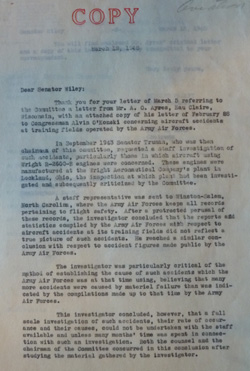| Wright R-2600 |

| ||
|---|---|---|---|
| |
| ||
 |
|||
|
The Wright R-2600. | |||
|
The Wright R-2600 Cyclone, designed and produced by the Curtiss-Wright Aeronautical Corporation, was a 14-cylinder, double-row, air-cooled radial engine. It was more famously known for the smaller aircraft it powered, rather than the larger craft. It was used in a variety of famous aircraft that included the Boeing 314, Curtiss SB2C Helldiver, Grumman TBF Avenger, Douglas A-20, Martin PBM Mariner, and North American B-25. Work began on the engine September 23, 1936 under the company's specification #439 and production began in 1938.1
During early development, it was plagued with problems and came under much scrutiny from the Truman Committee. In an Additional Report of the Special Committee Investigating the National Defense Program on aircraft, the committee found that there was widespread production of substandard and defective material. During an investigation of the Lockland Plant in Ohio, it was found there was falsification of tests and forging of inspection reports among many complaints. More than 25% of the engines tested, failed during a 3-hour test run.2 The incident was the inspiration for a play by Arthur Miller’s “All My Sons” in which a father, who produces faulty aircraft parts, contributes to the death of 21 P-40 pilots and even his own son. |
 |
|
Other problems included carburetor trouble and high oil consumption from ring wear and cylinder wall pitting. The problem got so bad that some thought it was sabotage and the FBI was called in, but they found no wrong doing. Pratt & Whitney had a similar problem where bearing surfaces were eroding away.3 The problem with the Pratt engines was finally isolated to acid buildup in the lubricating oil and the oil formulation was changed. Wright also used reformulated oil and its problems were corrected and the R-2600 went onto become a much improved engine.
Under normal operating conditions, the engine developed 1,700 hp (1,270 kW) for take-off, but the horsepower ranged from 1,600 hp (1,190 kW) up to a maximum of 1,900 hp (1,415 kW), depending on the model and configuration. It was a high compression engine with ratio of 6.9:1, requiring 100-Octane fuel. It had a bore of 6.124 in and stroke of 6.312 in. Total displacement was 2,603 in3 and it weighed 2,045 lb. More than 50,000 engines were produced with production tapering off by the end of the war. |
| Specifications: | |
|---|---|
| Wright R-2600 | Date: | 1938 |
| Cylinders: | 14 |
| Configuration: | Twin-row, air-cooled radial |
| Horsepower: | 1,700 hp (1,267 kW) |
| RPM: | 2,600 |
| Bore and Stroke: | 6.125 in. (155.6 mm) x 6.312 in. (160.2 mm) |
| Displacement: | 2,603 cu. in. (42.70 liters) |
| Diameter: | 55 inches (1,397 mm) |
| Weight: | 2,045 lbs. (928 kg) |
Endnotes:
|
1. Howard Mingos, ed. The Aircraft Year Book for 1939. New York: Aeronautical Chamber of Commerce of America, Inc., 1939. 417. 2. Investigation of the National Defense Program, Additional Report of the Special Committee Investigating the National Defense Program. S. Res. 71. July 7, 1943. 3. The Pratt & Whitney Aircraft Story. Pratt & Whitney: 1950. 101. 4. Herschel Smith. A History of Aircraft Piston Engines. Manhattan, Kansas: Sunflower University Press, 1993. 127. 5. Ed. Glenn D. Angle. Aerosphere, 1943. (New York: Aerosphere Inc.) |
© Larry Dwyer. The Aviation History On-Line Museum. All rights reserved.
Created October 30, 2013. Updated April 23, 2014.